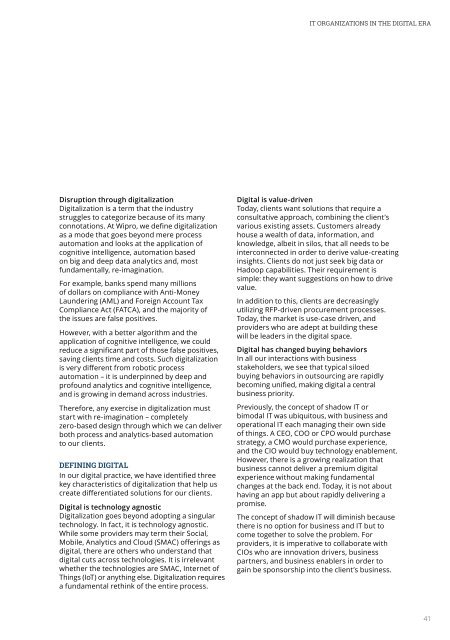IT Organizations in the Digital Era
ISG_Perspectives_Oct2016
ISG_Perspectives_Oct2016
You also want an ePaper? Increase the reach of your titles
YUMPU automatically turns print PDFs into web optimized ePapers that Google loves.
<strong>IT</strong> ORGANIZATIONS IN THE DIG<strong>IT</strong>AL ERA<br />
Disruption through digitalization<br />
<strong>Digital</strong>ization is a term that <strong>the</strong> <strong>in</strong>dustry<br />
struggles to categorize because of its many<br />
connotations. At Wipro, we def<strong>in</strong>e digitalization<br />
as a mode that goes beyond mere process<br />
automation and looks at <strong>the</strong> application of<br />
cognitive <strong>in</strong>telligence, automation based<br />
on big and deep data analytics and, most<br />
fundamentally, re-imag<strong>in</strong>ation.<br />
For example, banks spend many millions<br />
of dollars on compliance with Anti-Money<br />
Launder<strong>in</strong>g (AML) and Foreign Account Tax<br />
Compliance Act (FATCA), and <strong>the</strong> majority of<br />
<strong>the</strong> issues are false positives.<br />
However, with a better algorithm and <strong>the</strong><br />
application of cognitive <strong>in</strong>telligence, we could<br />
reduce a significant part of those false positives,<br />
sav<strong>in</strong>g clients time and costs. Such digitalization<br />
is very different from robotic process<br />
automation – it is underp<strong>in</strong>ned by deep and<br />
profound analytics and cognitive <strong>in</strong>telligence,<br />
and is grow<strong>in</strong>g <strong>in</strong> demand across <strong>in</strong>dustries.<br />
Therefore, any exercise <strong>in</strong> digitalization must<br />
start with re-imag<strong>in</strong>ation – completely<br />
zero-based design through which we can deliver<br />
both process and analytics-based automation<br />
to our clients.<br />
DEFINING DIG<strong>IT</strong>AL<br />
In our digital practice, we have identified three<br />
key characteristics of digitalization that help us<br />
create differentiated solutions for our clients.<br />
<strong>Digital</strong> is technology agnostic<br />
<strong>Digital</strong>ization goes beyond adopt<strong>in</strong>g a s<strong>in</strong>gular<br />
technology. In fact, it is technology agnostic.<br />
While some providers may term <strong>the</strong>ir Social,<br />
Mobile, Analytics and Cloud (SMAC) offer<strong>in</strong>gs as<br />
digital, <strong>the</strong>re are o<strong>the</strong>rs who understand that<br />
digital cuts across technologies. It is irrelevant<br />
whe<strong>the</strong>r <strong>the</strong> technologies are SMAC, Internet of<br />
Th<strong>in</strong>gs (IoT) or anyth<strong>in</strong>g else. <strong>Digital</strong>ization requires<br />
a fundamental reth<strong>in</strong>k of <strong>the</strong> entire process.<br />
<strong>Digital</strong> is value-driven<br />
Today, clients want solutions that require a<br />
consultative approach, comb<strong>in</strong><strong>in</strong>g <strong>the</strong> client’s<br />
various exist<strong>in</strong>g assets. Customers already<br />
house a wealth of data, <strong>in</strong>formation, and<br />
knowledge, albeit <strong>in</strong> silos, that all needs to be<br />
<strong>in</strong>terconnected <strong>in</strong> order to derive value-creat<strong>in</strong>g<br />
<strong>in</strong>sights. Clients do not just seek big data or<br />
Hadoop capabilities. Their requirement is<br />
simple: <strong>the</strong>y want suggestions on how to drive<br />
value.<br />
In addition to this, clients are decreas<strong>in</strong>gly<br />
utiliz<strong>in</strong>g RFP-driven procurement processes.<br />
Today, <strong>the</strong> market is use-case driven, and<br />
providers who are adept at build<strong>in</strong>g <strong>the</strong>se<br />
will be leaders <strong>in</strong> <strong>the</strong> digital space.<br />
<strong>Digital</strong> has changed buy<strong>in</strong>g behaviors<br />
In all our <strong>in</strong>teractions with bus<strong>in</strong>ess<br />
stakeholders, we see that typical siloed<br />
buy<strong>in</strong>g behaviors <strong>in</strong> outsourc<strong>in</strong>g are rapidly<br />
becom<strong>in</strong>g unified, mak<strong>in</strong>g digital a central<br />
bus<strong>in</strong>ess priority.<br />
Previously, <strong>the</strong> concept of shadow <strong>IT</strong> or<br />
bimodal <strong>IT</strong> was ubiquitous, with bus<strong>in</strong>ess and<br />
operational <strong>IT</strong> each manag<strong>in</strong>g <strong>the</strong>ir own side<br />
of th<strong>in</strong>gs. A CEO, COO or CPO would purchase<br />
strategy, a CMO would purchase experience,<br />
and <strong>the</strong> CIO would buy technology enablement.<br />
However, <strong>the</strong>re is a grow<strong>in</strong>g realization that<br />
bus<strong>in</strong>ess cannot deliver a premium digital<br />
experience without mak<strong>in</strong>g fundamental<br />
changes at <strong>the</strong> back end. Today, it is not about<br />
hav<strong>in</strong>g an app but about rapidly deliver<strong>in</strong>g a<br />
promise.<br />
The concept of shadow <strong>IT</strong> will dim<strong>in</strong>ish because<br />
<strong>the</strong>re is no option for bus<strong>in</strong>ess and <strong>IT</strong> but to<br />
come toge<strong>the</strong>r to solve <strong>the</strong> problem. For<br />
providers, it is imperative to collaborate with<br />
CIOs who are <strong>in</strong>novation drivers, bus<strong>in</strong>ess<br />
partners, and bus<strong>in</strong>ess enablers <strong>in</strong> order to<br />
ga<strong>in</strong> be sponsorship <strong>in</strong>to <strong>the</strong> client’s bus<strong>in</strong>ess.<br />
41


